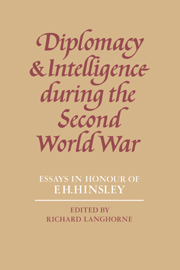5 - Vansittart's administration of the Foreign Office in the 1930s
Published online by Cambridge University Press: 21 September 2009
Summary
The way Sir Robert Vansittart administered the Foreign Office during his eight years as permanent under secretary has received no close study. Rather it is assumed that his overwhelming preoccupation with alerting ministers to the dangers of German resurgence led him to neglect both administration and reform. Admittedly most of his effort was devoted to discharging his responsibilities as an adviser on policy, and this effectively precluded him from initiating any far-reaching reform. But his preoccupation with policy itself led him to make significant administrative adjustments involving the Foreign Office's departmental structure and its deployment of senior personnel, so as to keep closer watch on foreign developments, and facilitate appropriate responses to perceived changes.
These adjustments clearly fulfilled Vansittart's formal administrative obligations, for in practice a permanent under secretary in the Foreign Office took no responsibility for routine administration, but concentrated on supervising the efficient distribution and handling of work, and making recommendations on senior appointments. This was the outcome of an arrangement introduced after the First World War, and maintained until 1938, whereby the permanent under secretary's functions as chief accounting officer were delegated to a principal finance officer, who oversaw the spending of monies voted by parliament, justified that expenditure before the public accounts committee, and shared day-to-day control over the Foreign Office establishment with a chief clerk.
- Type
- Chapter
- Information
- Diplomacy and Intelligence During the Second World WarEssays in Honour of F. H. Hinsley, pp. 68 - 84Publisher: Cambridge University PressPrint publication year: 1985



